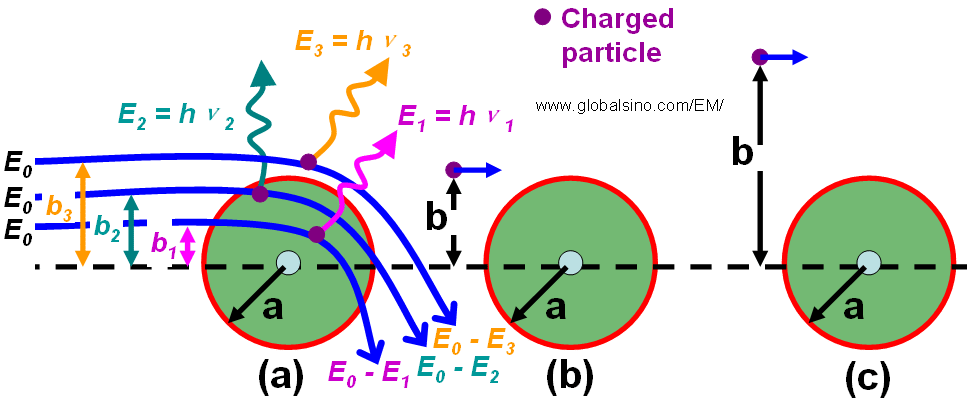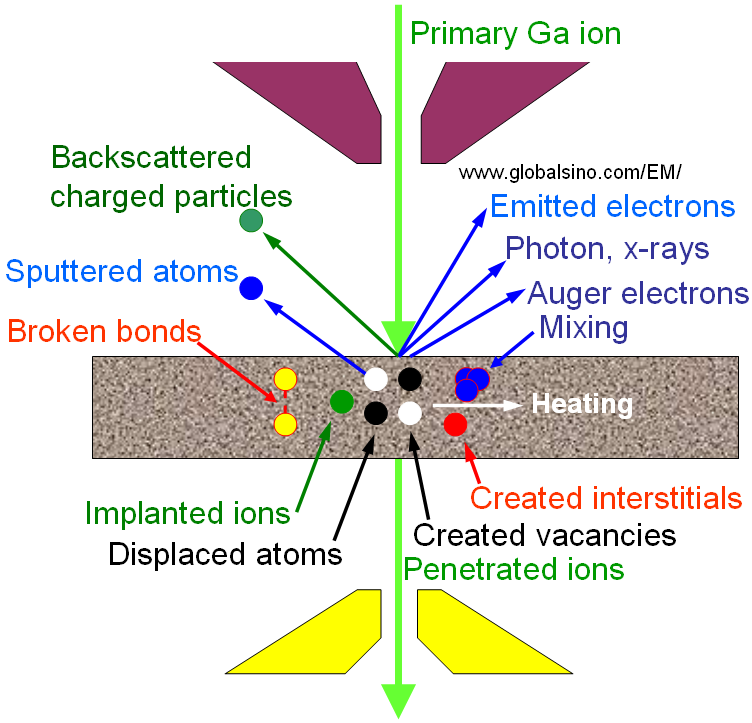=================================================================================
The charged particle experiences Coulomb interactions with the nuclei and the orbital electrons of the atoms in a matter when it travels through the matter.
Two basic classes of interaction processes, namely elastic and inelastic interactions,
can occur between incident ions and target atoms. Inelastic processes are composed of secondary electrons, Auger electrons, X rays, optical photon emission and bond breaking as shown in Figures 4429a and 4429b. In the inelastic processes, only secondary electrons are intensive enough to be detected by far and thus it is the most useful inelastic process with FIB beams.
Elastic processes include
the displacement of atoms, sputtering of surface atoms and the formation of
defects (vacancies and interstitials) as shown in Figure 4429b.
As shown in Figure 4429a, these interactions can be divided into three categories depending on the impact parameter b compared with the atomic radius a: a) Interaction with the external nuclear field (bremsstrahlung production) for b << a; b) Interaction with the orbital electrons for b ≈ a (hard collision); c) Interaction with the orbital electron for b >> a (soft collision). On the other hand, the particle experiences a large number of interactions before its kinetic energy is completely lost. Some important parameters of charged particle interaction with matter are stopping power, the range, energy transfer, mean ionization potential, and radiation yield.

| Figure 4429a. Radiative (a), hard (b) and soft (c) collisions. b is the impact parameter and a is the atomic radius. |
Figure 4429b shows the products of interaction between incident charged particles and matters. These
processes do not happen with equal probability. Besides the signals generated by FIB beam, FIB irradiation also causes sample damages, including displacement of atoms and creation of vacancies.

| Figure 4429b. Products of interaction between incident charged particles and matters. Emitted ("Secondary") electrons; green discs: backscattered/reflected charged particles or called ions; blue discs: sputtered atoms or called positive, negative and neutral ion emission; black disks: displaced atoms; white disks: created vacancies; green disks: implanted (dopped) ions from the beam (e.g. Ga); red disks: interstitial production; yellow discs: bond breaking; overlapped blue discs: mixing. |
Table 4429. Signal per ion particle.
| Ion in beam |
Ga+ |
| Beam voltage |
25 kV |
| Secondary electrons |
1.5–2.5 |
| Backscattered electrons |
0 |
| Substrate atoms |
5.5 |
| Secondary ions |
0.35 |
| X-ray |
0 |
|